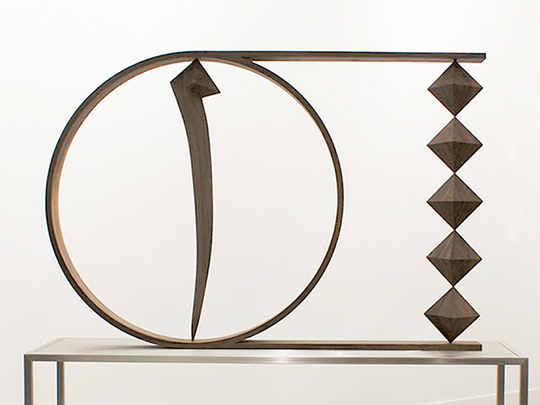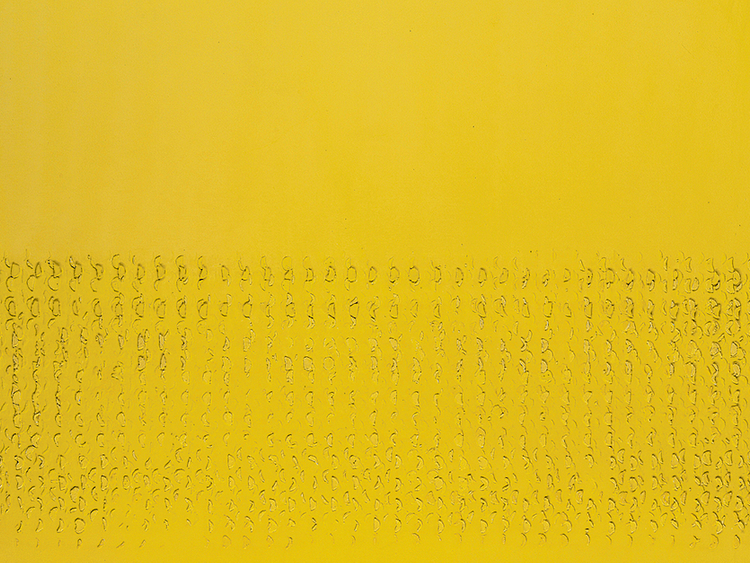
The latest exhibition at The Farjam Foundation, “Zero: Infinite Possibilities”, is inspired by the German art movement “Zero”, founded in 1957 by Otto Piene and Heinze Mack. The artworks, selected from The Farjam Collection, include an iconic piece by Piene along with works by Daniel Firman, Fabrice Hyber, Mark Francis, Gulay Semercioglu, Michael Sailstorfer, Walid Raad, Timo Nasseri, Kathy Prendergast, Peter Peri, Sylvie Fleury, Carlos Rolon and Rana Begum.
According to Piene, “Zero” expressed a zone of silence and pure possibilities for a new beginning, and of creating a new world from elements of nature, human ingenuity, universal energy and technology. Taking off from this concept of Zero as infinite, the show explores infinite possibilities of artistic expression with artworks in a diverse range of media such as sculpture, mapping, installation, painting, mixed media on paper and neon lights. Each of the 15 featured artists offers a fresh perspective on the fundamental vision of a new aesthetic and investigates nature and form through the deconstruction of language, communication and material.
The show challenges our perception of reality by merging art with science, creating a renewed harmony between man and nature, and restoring art at the metaphysical dimension.
The pivotal piece in the show is “Gelb 2” — a painting by Piene, created in 1960 during the early years after the formation of Group Zero. The artist was fascinated with light; and the yellow paint covering the entire canvas in this minimalist, monochrome oil painting symbolises the emission of light. By adding chunks of the same paint on the canvas, Piene has created a 3-D effect, using the shadows and highlights thus created to play with the perception of space.
Similarly, French sculptor Daniel Firman’s colourful light installation, “Butterfly #2” also explores the compression and expansion of space using bands of different coloured light.
Korean sculptor Seon Ghi Bahk is known for using natural materials as a medium to comment on the relationship between man and nature. His piece, titled “An Aggregate”, is a frame created from bits of charcoal suspended with wire. But with one corner of the frame missing, it is not clear whether the frame is being destroyed or repaired. The work thus highlights the fragility of the Earth and our relationship with it.
German artist Michael Sailstorfer’s sculpture “Voila (Dubai) 2”, featuring a larger than life aluminium vase filled with flowers made from colourful light bulbs also speaks about the relationship between man and nature, and human interference in the cycles of nature.
French artist Fabrice Hyber also takes inspiration from nature, especially trees and roots, to create what he describes as his “Homeopathic paintings”. His work in this show, titled “A-Codable”, is a monumental oil painting of a forest. With words scribbled on the canvas and notes pinned on to it, the work is essentially a vision board of the artist’s inner world, but it invites infinite interpretations by individual viewers.
The pieces by Irish artist Kathy Prendergast, New York-based Lebanese artist Walid Raad and Carlos Rolon, who is of Puerto Rican origin but grew up in Chicago, are also quite personal, but comment strongly on their sociopolitical environment.
Prendergast often uses mapping as a metaphor for control. In her “Love Lake” series the artist focuses on lakes on a map that is covered with red paint to speak about the Irish struggles for independence.
Raad’s work, “History of a Monograph”, belongs to a series titled “Scratching on Things I could Disavow” which looks at the way war has destroyed not only the personal lives of the Lebanese but also the culture. In this particular work, blank sheets of paper speak about the stories that are lost with every person killed by the war.
Rolon’s vibrant untitled works featuring glass beads and resin refer to his childhood memories of his mother’s nail salon, and address issues about his identity and relationship to his Puerto Rican heritage.
German-Iranian artist Timo Nasseri’s work explores Middle Eastern art with a Western twist. He is particularly interested in the intricate patterns of the “Muqarnas” in mosques, and the mathematics behind the patterns. His minimalistic work “Alif” combines a wooden sculpture inspired by the curves and geometry of Islamic art placed on a metal table with clean lines.
Iranian artist Golnaz Fathi also combines Islamic calligraphy with abstract expressionism to create meditative, abstract paintings that express her psychological, sensory and emotional experiences at a particular moment in time.
Other abstract works in the show include Turkish artist Gulay Semercioglu’s nature-inspired piece made from enamel-coated wire on wooden board; British-Bangladeshi artist Rana Begum’s kinetic enamel sculptures; Irish artist Mark Francis’s paintings that attempt to capture the movement of bacteria and to visualise sound; the acrylic paintings of Swiss pop artist Sylvie Fleury; and a mixed media painting by Hungarian artist Peter Peri, who is known for restricting his materials to a silver marker pen and spray paint in four colours, and giving thought provoking titles to his mystical works.
Jyoti Kalsi is an arts enthusiast based in Dubai.
“Zero: Infinite Possibilities” will run at The Farjam Foundation, DIFC until June 16.














